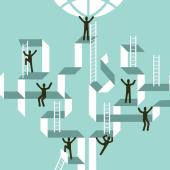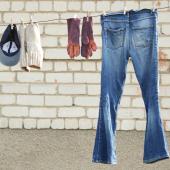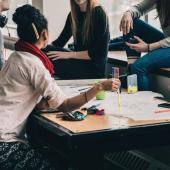What Is Social Safety? — With Linda Ray
There is so much going at home right now! Domestic and work responsibilities are colliding. There seems to be no way out, like two steam trains heading toward each other down the same track.
As a result, people are not coping. People’s wellbeing is slipping and performance is following. Teams simply don’t know how to collaborate in the online workplace. The struggle to draw lines between work and home lead many to feel they are no longer trusted to do their job professionally. As a result, many people burn out. Today it seems we cannot cope. This is the new normal.
So we need to build an emotional safety net so that people can cope.
Protecting physical safety has been and continues to be an obvious priority, but people think they have to be at their home office desk 24/7. As a result, mental health is now a massive priority.
Humans are social organisms that live and work collectively in interacting populations and groups. Fundamentally, humans are social beings. And to feel psychologically safe, we need a space of social safety. This is an emotional safety net looking more and more like improving team culture. Work needs to be a place of social safety.
The concept of psychological safety described by Professor Amy Edmondson is impressive research. It explains that we need a safe place for interpersonal risk-taking. Her work has been gaining attention after her model was applied by global giants such as Google.
In a quest to understand the key ingredients of high-performing teams, Google launched a study — Project Aristotle. After crunching and slicing the data, they found group norms played a key role more than anything else.
The Google Aristotle study explained that the degree to which a person feels psychologically safe is influenced by the emotional state of each person in a team. If we strip this idea back to its most fundamental, it comes down to one key question: Do I feel safe or not safe? Feeling safe or not safe is moderated by the social context we operate within (e.g. a team, a neighborhood, family).
So why do we have such a high neuro-biological need to feel safe? The primary role of your brain is to keep you alive and safe — safe enough to breed. Outside of your conscious awareness, you take in cues through your senses from the environment and match this with past experiences to guide the actions you take to stay safe. It is this predictive focus that means you are making assessments in microseconds that help you deal with the world around you and guide action and behavior.
Neurologically, we need a consistent drip of oxytocin to thrive. Oxytocin is often called the “trust hormone.” It is a neurotransmitter that is released when we feel safe and trusted, which leads to a felt sense of bonding. It is released during breastfeeding to build that intimate and vital mother-child relationship.
Whilst it is clear we rely on this state of wellbeing to keep us physically safe we also rely on the same predictive focus to keep us socially safe. And if we are socially safe, we get all these neuropsychological rewards that breed new ideas.
The first neurological reward is dopamine. This is the reward the brain gets we get when we complete a task effectively, no matter how big or small. Even the believe we might get a reward, the brain produces dopamine. This, in turn, produces serotonin, which makes us feel like we are in a good place — a place like we are sun-bathing on a warm day, with a cool breeze, on a tropical island, with a cocktail in one hand, a bestseller in the other (you get the point).
But in order to get these feelings, we need the motivation to change. Any change is stressful. This requires epinephrine (adrenaline) to give the energy to do something. If we don’t get that oxytocin "kick" we’ll struggle to feel better, which if sustained with us feeling bad, causes chronic stress. And this is followed by physical and mental disease. Too much cortisol is then released in the brain and the ability to connect socially becomes retarded. And down the rabbit hole, we go! We feel socially unsafe and not only affects us personally but also causes a breakdown in the team.
In other words, we must ask the fundamental question: Am I safe? As we are social beings, we are constantly assessing the social context we find ourselves in to determine our personal safety. Neurologically, this is done in the same way we monitor our environment to assess our physical safety.
Whether we feel safe or not safe fundamentally impacts how we engage and interact with others. Whilst Amy Edmondson describes psychological safety as "a shared belief that a team is a safe place for individual and interpersonal risk-taking" it may be better defined as "an individual’s perception that they feel socially safe to engage in interpersonal risk-taking." This might be only a slight difference, but in the academic backwaters, this is being proposed as a model of Social Neuropsychological Safety. But that is best left for academic journals. The point is simple. We first need to feel socially safe. This results in others feeling safe. Psychological safety follows. Our self-awareness then tells us this is an OK (social) place to be.
Each person’s experience of their social interactions within a social context is unique. The norms developed within a group influence the experience of each individual. A person’s feeling psycho-socially safe (or not safe) is a result of their assessment of the social situation. Psycho-social safety is an intrapersonal construct. It is the felt experience that influences the mental (cognitive) and emotional (neurophysiological) wellbeing of a person. Our assessment of our social safety is an assessment of our interpersonal environment.
Our feelings (of Social Neuropsychological Safety) are moderated by our assessment of whether or not our social context is an OK place to be in. Is it a safe place to share? And this also applies to customers. From the moment your customers interact with staff, it takes place in a social context, and they too are assessing their own social safety. This directly impacts their willingness to purchase or even engage.
To begin with, the end in mind, feeling safe is first and foremost your responsibility. Because if you don’t feel safe, then stress and chronic disease follow quickly. At work, if you want your team to perform at its peak — start with a Google search. Find ways to launch your own Aristotle Project so that everyone feels a deep sense of social neuropsychological safety.
Team performance improvement is a direct consequence. It all starts by taking an assessment of how you feel and how the team culture "feels." How does the quote go? “Together we stand, divided we fall”.






